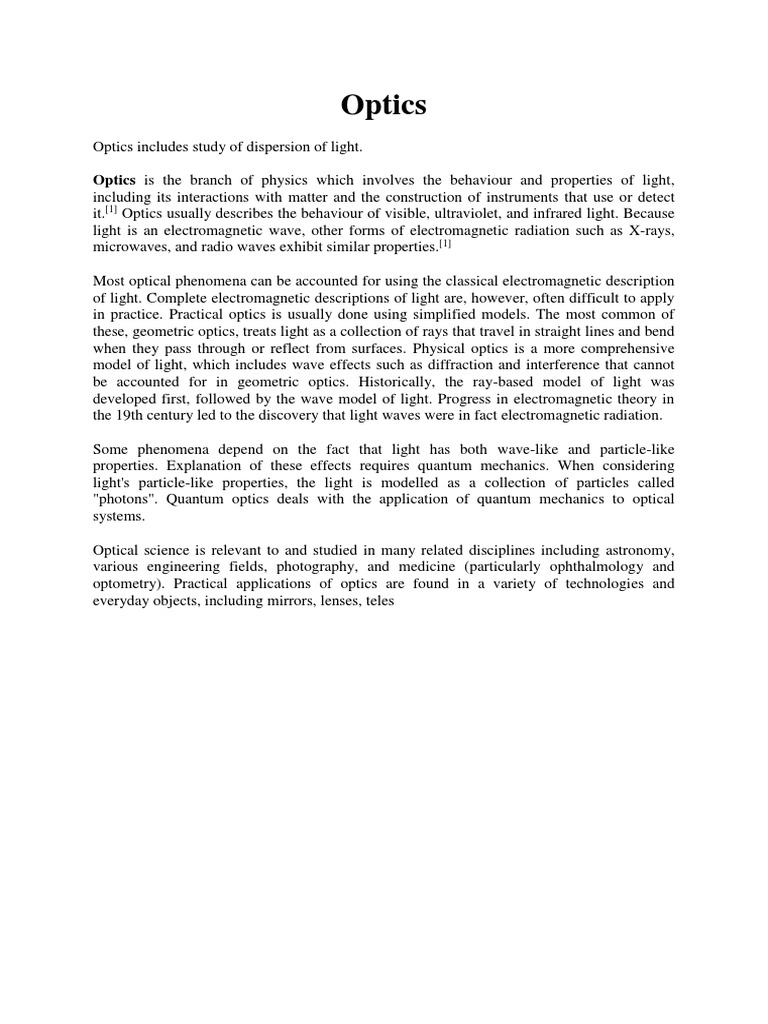Throughout the history of physics, the field of optics has persistently been a wellspring of intellectual inquiry and theoretical debate. At the heart of this exploration lies the optics dilemma, a clash of interpretations that has confounded physicists for over a century. This article delves into the nexus of light’s dual nature—wave and particle—illuminating the philosophical and scientific implications of these divergent perspectives.
The dichotomy between wave and particle theories of light is deeply entrenched in the annals of scientific advancement. Historically, the work of Christiaan Huygens in the late 17th century set the stage for wave theory. Through his wavefront hypothesis, Huygens posited that light propagates as a wave, spreading out in all directions. This paradigm was further solidified with the advent of James Clerk Maxwell’s equations in the 19th century, which described light as an electromagnetic wave. Maxwell’s synthesis linked electricity, magnetism, and optics, encapsulating the burgeoning understanding of light as a wave phenomenon.
Conversely, the particle theory owes its inception to the investigations of Isaac Newton, who proposed that light is composed of discrete particles, or corpuscles. Newton’s conjecture excelled in elucidating reflection and refraction phenomena effectively. However, by the 19th century, empirical evidence garnered through experiments such as Thomas Young’s double-slit experiment provided substantial support for the wave model, leading to its predominance in scientific discourse.
The tide began to shift dramatically in the early 20th century with the emergence of quantum theory. Max Planck’s introduction of quantized energy levels and Albert Einstein’s photoelectric effect illuminated the existence of light as both wave and particle. Einstein’s findings elucidated that light could eject electrons from a material only when its frequency surpassed a certain threshold, reinforcing the particle aspect of light’s nature. Such revelations led to the conception of photons—light particles epitomizing the corpuscular view—thus dismantling the rigid boundaries between the two paradigms.
Despite these advancements, the optics dilemma persists. The crux of the issue lies in the wave-particle duality of light, encapsulated succinctly by the phrase “both right.” This duality poses profound implications for our understanding of reality. Wave models excel in phenomena involving interference and diffraction, where light exhibits characteristics such as constructive and destructive overlaps. Meanwhile, the particle perspective adeptly explains phenomena such as the photoelectric effect and Compton scattering. However, reconciling these two interpretations has proven elusive, resulting in a fragmented view of light and its behavior.
Philosophically, this dilemma invites scrutiny into the nature of scientific theories. Are they mere models to approximate reality, or do they reflect an intrinsic truth about the cosmos? The debate echoes the historical contention between realism and anti-realism within the philosophy of science. Realists argue that scientific theories provide an accurate depiction of the world. In contrast, anti-realists contend that theories are merely instruments for making predictions without requiring an epistemological alignment with reality.
This ontological question manifests prominently in the realm of quantum mechanics, particularly in the interpretation of quantum superposition and entanglement. The Copenhagen interpretation, for instance, suggests that light behaves as a wave until observed—an assertion that raises profound questions regarding the role of the observer in the measurement process. Conversely, the many-worlds interpretation posits that all possible outcomes coalesce into distinct realities, fundamentally altering our conception of causality and determinism in physics.
Moreover, contemporary research into quantum optics has reaffirmed the significance of understanding light’s dual nature. Experiments utilizing quantum entanglement and Bell’s theorem challenge conventional notions of local realism, suggesting that entangled particles exhibit correlations that cannot be accounted for by classical physics. Such findings underscore the necessity of an integrative framework capable of encompassing wave and particle duality, leading to potential insights that transcend traditional paradigms.
In light of the ongoing debates and experimental discoveries, the optics dilemma serves as a focal point for pedagogical and research pursuits in physics. Educational programs increasingly emphasize the importance of presenting both wave and particle theories as complementary perspectives rather than opposing doctrines. This holistic approach fosters a comprehensive comprehension of light’s complexities and prepares nascent physicists to grapple with the unresolved enigmas that permeate the field.
Looking forward, the optics dilemma will likely continue to stimulate inquiry and innovation. The emergence of advanced technologies, such as quantum computing and photonics, will necessitate an adaptive understanding of light’s behavior, inviting new interpretations and potential resolutions. Furthermore, interdisciplinary collaborations that merge insights from philosophy, cognitive science, and experimental physics are essential in formulating coherent frameworks that encompass light’s multifaceted nature.
In summary, the duality of light as both wave and particle exemplifies a profound conundrum that has challenged physicists for over a century. The interplay between these interpretations enriches our understanding of the physical universe while prompting philosophical reflection on the nature of scientific theories. As research progresses, the optics dilemma will remain a cardinal issue, driving the evolution of physics and our comprehension of reality itself. The quest for a cohesive narrative that reconciles this dichotomy is not merely an academic exercise; it’s an exploration of the very fabric of existence.












